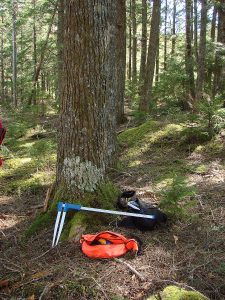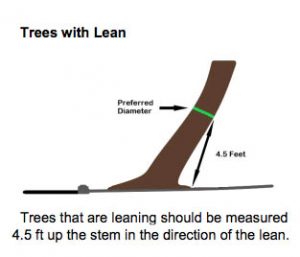 “Forest mensuration is one of the most fundamental disciplines within forest and related sciences. It deals with the measurement of trees and stands and the analysis of the resultant information.” Another definition: [Forest mensuration is] “the art and science of providing the quantitative information about trees and forest stands necessary for forest management, planning and research.” Such measurements are the basis of sustainable harvest calculations for Nova Scotia.
“Forest mensuration is one of the most fundamental disciplines within forest and related sciences. It deals with the measurement of trees and stands and the analysis of the resultant information.” Another definition: [Forest mensuration is] “the art and science of providing the quantitative information about trees and forest stands necessary for forest management, planning and research.” Such measurements are the basis of sustainable harvest calculations for Nova Scotia.
The Science and Methodology
Forest Finance 8: To Cut or Not Cut- Deciding When to Harvest Timber
Penn State Extension “This publication discusses issues pertaining primarily to the financial decision to harvest timber. The first section is a brief overview of how to estimate timber value and price. The next section covers what is meant by forest “maturity,” and the final section shows how to determine and calculate when to cut timber to maximize financial returns.”
Forest Productivity Enhancement and Compensatory Growth: A Review and Synthesis
Chao Li et al., 2020. Front. Plant Sci., 29 “This review and synthesis article attempts to integrate observations from forestry to contemporary development in related biological research fields to explore the issue of forest productivity enhancement and its contributions in mitigating the wood supply shortage now facing the forest sector. Compensatory growth has been clearly demonstrated in the long-term precommercial thinning and fertilization trial near the Shawnigan Lake, British Columbia, Canada. This phenomenon appears similar to many observations from other biological fields. The concept of compensatory growth can be applied to forest productivity enhancement through overcompensation, by taking advantage of theories and methods developed in other compensatory growth research. Modeling technology provides an alternative approach in elucidating the mechanisms of overcompensation, which could reveal whether the Shawnigan Lake case could be generalized to other tree species and regions. A new mitigation strategy for dealing with issues related to wood supply shortage could be formed through searching for and creating conditions promoting overcompensation. A forest growth model that is state dependent could provide a way of investigating the effect of partial harvest on forest growth trajectories and stand dynamics. Results from such a study could provide cost-effective decision support tools to practitioners.”
FRM 503 LECTURE NOTES FOREST MANAGEMENT TECHNIQUES
by DR. MICHAEL FEMI ADEKUNLE ASSOCIATE PROFESSOR AND PROFESSOR S A OLUWALANA
DEPARTMENT OF FORESTRY AND WILDLIFE MANAGEMENT, UNIVERSITY OF AGRICULTURE, ABEOKUTA, OGUN STATE,NIGERIA.
A very clear descrription of the theory of forest management. Unfortunately. 2 graphs are not shown in full, but it is still a very useful intro for non-foresters.
Scientists create a ‘video game of the forest’ to check the impact of climate change
By Carl Meyer in the National Observer Oct 5, 2018. “For decades, gathering data about the forest has been painstakingly done by hand, or in later years captured from above, from digital sensors on planes flying over the forest or from satellite data. Now, 3-D scanning technology can be put directly into scientists’ hands, allowing them to digitally map forests themselves more quickly and precisely, with more detail. “We can now map the distribution of trees” with LIDAR, explained Scott McPherson, planning forester and analyst for Nipissing Forest Resource Management Inc. The Contour device sends out a continuous signal and generates a field of points. The holder walks around to get different angles of trees. Eventually a 3D model of the forest is produced. Scientists manipulate the model to view different data points using software called CompuTree.”
CCC Forestry: Forest Mensuration
US Forestry Service. A good description of the techniques and instruments traditionally used in measurements. It is Ch VIII in CCC Forestry (1937). (CCC is Civilian Conservation Corps)
“Forest mensuration has undergone a number of important changes in recent years. Among the most notable are laser and ultrasound based measuring devices, and use of drones, terrestrial and airborne laserscanning, satellite imagery and other advanced remote sensing techniques that are being used to measure and monitor trees and forests. These devices have reduced considerably the time needed for field measurements and can be used to quickly obtain many tree characteristics including spatial positions. Additionally, new methods have been developed for conducting tree-ring analyses including techniques for assessing the physical, chemical, and anatomic properties of wood. Such measurements are being used for reconstructions of growth conditions and investigations of the impacts of environmental changes on forest growth.” – IURFO
Changing technologies: Leading Edge Geomatics
Based in new Brunswick. View also Fredericton’s Leading Edge Geomatics Ready for Takeoff With New Investment (Nov 20, 2017 in Huddle)
Biometric Methods for Forest Inventory, Forest Growth And Forest Planning: The Forester’s Guidebook
James D. Arney, 2014. Forest Biometrics Research Institute. The section ” Introduction to Quantitative Forest Management Methods”pp 1-10 are especially informative for non-foresters.
Tree and Stand Measurement
By Dr Mathias (Mat) Disney, University College London. “The simple techniques described in this paper have their limitations and are not suitable where a high degree of accuracy is required, however, they are suitable for most farm forestry situations and only require cheap equipment and basic mathematical skills.” Originally published in The Farmers Log 1999/
Lecture Notes for Forest Mensuration
Bechu K.V. Yadav, prepared 2009. Comprehensive, well laid out. 333 slides in PDF document.
Examples of Mensuration Tools
Basic Forest Measuring Tools Used by Foresters
Forestry Tools
Forest Mensuration: Measuring trees, stands and forests for effective forest management
Set of web pages pages on Fenner School of Environment and Society, Australian national University. Posted in 1997, some not maintained. probably most useful is the the Index page for Forest Mensuration. See also: Code of Forest Mensuration Practice and the Introduction Page, Forest Measurement and Modelling.
Forest Mensuration
Anthonie van Laar & Alparslan Akça. 2007. The entire Springer Volume is available online.
Assessing Trees and Woodlands (Videos)
University of Kentucky Forestry Extension videos showing woodlot owners how to measure or determine Tree Height, Growth Rates and Tree Ages, Size Classes & Management, Growing Stock, Tree Volume, Tree Diameter, Woodland Density, Crown Classes and how to set up a Sample Inventory Plot. See Forestry 101: Woodland Terms Part 1 and Part 2 for descriptive definitions of terms such as basal area, crown class, dbh, tree grade.
 Tree Diameter Measurement
Tree Diameter Measurement
New York State Department of Environmental Conservation
Urban and Community Forestry Grant Program Round 15
Guidelines for Awardees and Consultants
Pertaining to Nova Scotia
Forestry Field Handbook
NSDNR “This handbook includes site specific softwood and hardwood silviculture keys together with graphs and tables needed to estimate present and future stand characteristics… The growth projections and keys were developed by the Department of Natural Resources from research data and private and government experience. They are applicable to a wide variety of forest conditions, since decisions regarding the choice of silviculture treatments are based on specific site and stand characteristics.”
Growth of forests in Canada. Part 2: A Quantitative description of the land base and the mean annual increment. (1981).
Bickerstaff, A.; Wallace, W.L.; Evert, F. Environment Canada, Forestry Service, Petawawa National Forestry Institute, Chalk River, Ontario. Information Report PI-X-001. 136 p.
Ten Year Periodic Annual Increment For Nova Scotia Permanent Forest Inventory Plots 1990-95 to 2000-05.
NSDNR June 4, 2007
Land Capability and Site Index Curves for Nova Scotia Hardwoods
NSDNR 2011
Revised Normal Yield Tables for Nova Scotia Softwoods.
NSDNR 1990
FOREST SUSTAINABILITY A Grade 10 Science Program
A Program of the Natural Resources Education Center Middle Musquodoboit, Nova Scotia (no date)
Hansard: STANDING COMMITTEE ON RESOURCES, HALIFAX, TUESDAY, MAY 25, 1999
Search page for “mean annual increment”.
Measurement of Tree Basal Area & Volume
FOR 1001 Fall 2012. Notes by Dr. Thom Erdle. See other Lecture Notes; 1) Measure of Tree Diameter & Height 2) Sample Plots 3) Measurement of Tree Basal Area & Volume 4) Tree Biomass & Carbon Price & Cost Information 5) Point Sampling 6) Snags and Coarse Woody Debris 7) Basic Data Concepts 8) Sampling Concepts Part 1
Assessing Tree Attributes
On http://courses.washington.edu. measurements at “breast height” etc.
Variability in early height growth rate of forest trees: implications for retrospective studies of stand dynamics
Brian J. Palik and Kurt S. Pregitzer. Can. J. For. Res. 25:767-776 (1995). Data on years to reach breast height for diff species.
Field Technique Tips for Counting Whorls
In Forest Measurements: An Applied Approach by Joan DeYoung Open Oregon Educational Resources . No date
3. How to measure: Special techniques for trees
Wedge Prism
Wikipedia ” the wedge prism is used to estimate basal area of a group of trees by counting trees which are “in” or “out” of a plot centered on a single point”
Low tech prism alternative by Medway Community Forest Co-op
Rainy day prism sweeps as we check on a contractor completing a partial harvest on a neighbouring woodlot in South Brookfield. The aim of this cut is to release existing regeneration and promote growth in shade-suppressed hemlock, pine and spruce. Angle gauges, versus the traditional prism are the fastest and easiest way to determine basal area (cross section area of stump).
Comparison of Combinations of Sighting Devices and Target Objects for Establishing Circular Plots in the Field
Sylvio Manne et al., USDA 2006
CRUSIER’S CRUTCH
What is the “Cruiser’s CrutchTM“? Designed by Foresters For Foresters!
Woodland Management – University of Maryland Extension
TIMBER CRUISING HANDBOOK
FOREST SERVICE HANDBOOK WASHINGTON FSH 2409.12 – TIMBER CRUISING
Equipment Used to Cruise Timber and How to Use It
www.thoughtco.com
Simple Homemade Forestry Tools for Resource Inventories
By Donald P. Hanley, Extension Forestry Professor Emeritus, and J. Alan Wagar, Forestry Professor Emeritus,
University of Washington. Copyright 2011 Washington State University
418 rings set tree record
CBC News · Posted: Apr 12, 2007 . “A university student has found what’s believed to be the oldest tree in Nova Scotia — a 418-year-old eastern hemlock…Mount Allison students appear to have a knack for spotting old trees. In 2005, Ben Phillips found a 445-year-old red spruce — the oldest of its kind in the world — while walking along the Bay of Fundy coast in New Brunswick.”
Development of regional height to diameter equations for 15 tree species in the North American Acadian Region
Baburam Rijal et al., 2012. Forestry: An International Journal of Forest Research, Volume 85, Issue 3, 3 July 2012, “Equations that relate individual tree diameter at breast height (d.b.h.) and total height (HT) are important because HT is not widely measured and is often needed to estimate stem volume or predict HT growth. The primary goal of the study was to construct a regional HT to d.b.h. equation (H-D) for 15 tree species of the Acadian Region. Specific objectives were to (1) evaluate performance of the Forest Vegetation Simulator Northeast Variant (FVS-NE) equations, (2) explore suitable model forms and compare the influence of various tree- and stand-level variables on HT prediction and (3) develop species-specific equations that are unbiased across a broad geographic region. Data were available from an extensive database covering Maine, three provinces of the Canadian Maritimes and southern Québec. The study showed that the widely used FVS-NE model had significant prediction biases for all species in the region. The best model form among those evaluated was the von Bertalanffy–Richards (vB-R; commonly referred to as the Chapman–Richards), with added covariates that included crown competition factor, basal area in trees larger than subject tree and a climate-derived site index.”

